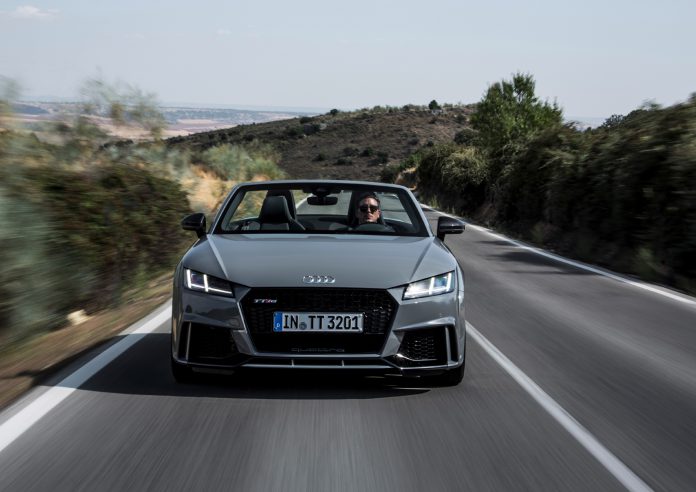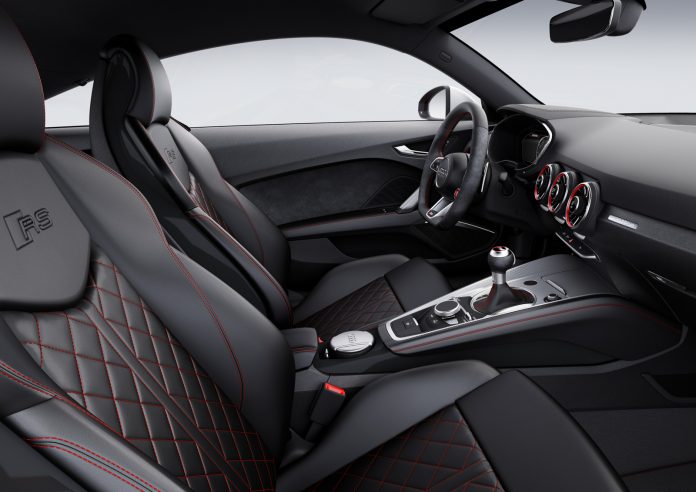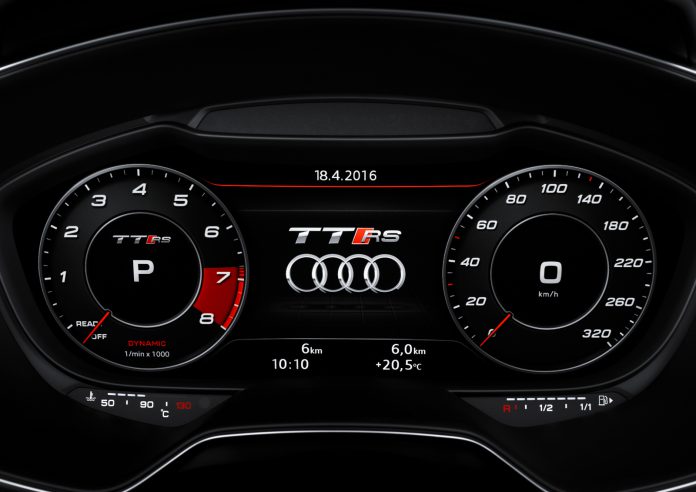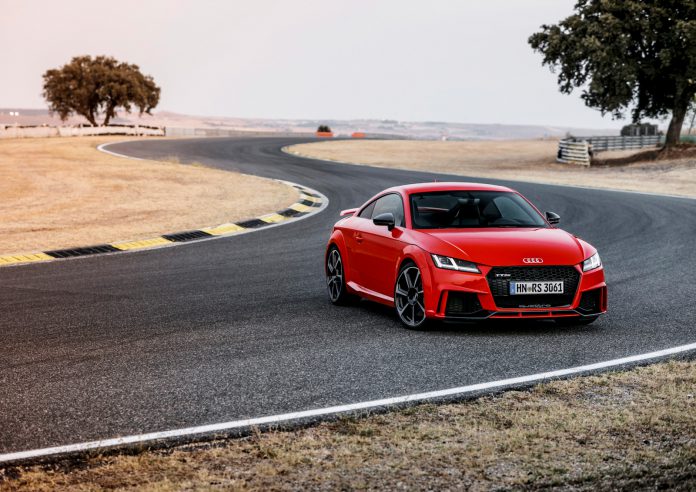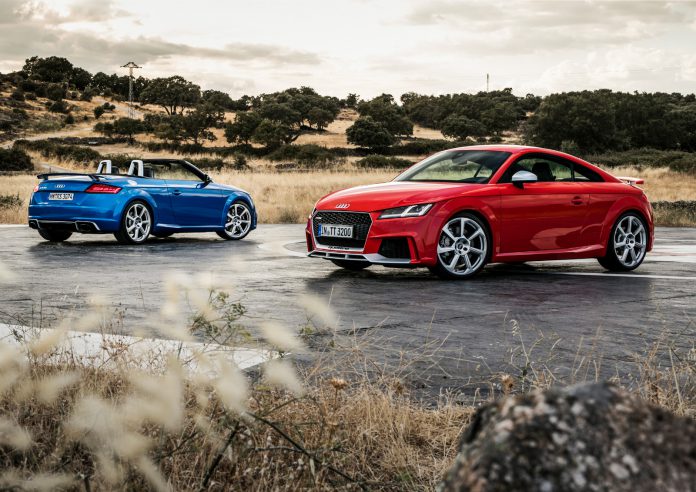My experience driving the 2017 Audi TT RS started off rather unusual, and by that I don’t mean the wrong turn that I took right after leaving the Jarama Racing Circuit right outside Madrid, which was our ‘home base’ for the day. Taking a wrong turn happens every so often to me during these press drives and I always feel inclined to blame it on the speed of the navigation system or the terribly designed infrastructure. But in fact usually it’s just me trying to learn the ways of the car and infotainment system, which in this case didn’t make any sense because it’s probably the 10th Audi with Virtual Cockpit that I had driven in the same year.
So, it was definitely the illogical way this Spanish roundabout was set up, that some native drivers seem to interpret as a junction. While my view on Spanish infrastructure design is fairly irrelevant, I felt compelled sharing this with you as I wasn’t the only one that took the wrong exit. As I cruise down the Autopista, roof down, warm Spanish autumn sun fulfilling my daily dose of Vitamin D, I am accompanied by a colleague journalist driving the ‘Ara Blue’ Audi TT RS. Driving both with the roof down, we provided each other with a unique perspective of the vibrant two-seater whilst making our way towards the more challenging mountain roads, having all forgotten about that wrong turn in the beginning.
The Audi TT is relatively unfamiliar territory for me. I have never really crossed paths with it one way or the other, let alone drive it. It’s this one afternoon, on a sunny day halfway through September in Spain, on which I was to be convinced of the capabilities of the TT’s most potent version. I arrived somewhat early, giving me some extra time behind the wheel right around noon. With all the test vehicles neatly lined up on the parking lot, I resolutely picked the ‘Nardo Grey’ roadster. Nardo Grey is one of those special Audi RS colors that really intrigues me, it’s simply something I would want for myself.
The TT RS is by all means a very compact car with a muscular appearance. Aggressive and sharp lines courtesy of Audi’s most recent design language give the two-seater a rather angry face, further underlined by the optional matrix LED lights and firm front splitter with engraved Quattro logo. I prefer the paint to sample splitter on the Nardo Grey car over the Ara blue and Catalunya red examples, where its given a contrasting shade of white.
The car stuns on the side too, the massive optional 20-inch wheels look even more impressive considering the TT’s length which is just over 4 meters. The bulky rear forms quite a contrast with the more chiseled front, but it’s just as detailed and refined. The ultimate example is the brand new OLED taillights, the first of its kind in a production series Audi, forming an attractive highlight with the vibrant square shapes. Then there is the rear wing that adds a further sense of sportiness without it having a too prominent presence. Finally the signature twin-tailpipes will make you aware it’s by all means an Audi RS product.
For me to assess the interior, I for once don’t have to open the door and get in. The roadster in front of me was already roofless and I must say, its saddle-brown interior looked stunning in the sunshine. It contrasts nicely with the exterior lacquer and gives a further sense of luxury, something that suits the convertible exceptionally well, granted you would opt for the more sporty and neutral black in the slightly faster coupé.
Audi went all out on the TT RS and offers a comprehensive options list for customers looking to make their new two-seater more exclusive. My test vehicle was specced with quilted leather sport seats and an abundance of carbon fiber inserts. It’s the type of options you’d expect from the R8, but that come as a surprise in a car like this.
Getting behind the wheel, adopted from the R8 by the way, I had some trouble positioning myself. I measure an acceptable 1.88 / 6’ 2 but hit the lowest seating position fairly quickly without being able to further up the height of the steering wheel, not giving me the amount of space I prefer in order to comfortably maneuver my legs. Whether this is related to the size of the car is something I’m not certain of, although I have never had any seating issues with any other Audi before.
Setting up the navigation I was anxiously looking for the conventional monitor that elegantly slides out of the dash, to find out that it’s not there. The new Audi TT RS requires you to work with its Virtual Cockpit (VC) only, which is fine, but takes some getting used to. The 12.3-inch tft screen that replaces the analog instruments is an intuitive display and easy to control via both the mid-console but preferably the steering wheel. The TT RS’ steering wheel is fairly small and comes with a flashy red start / stop button, as well as an integrated drive mode select knob.
By the push of a button the TT RS’ five-cylinder comes to life with a firm growl. I was told not to overlook the ‘sport exhaust’ button in the mid-console, supposedly liberating an even louder noise that would exceed that of the monstrous RS6 Avant. While that statement brought an instant smile to my face and got me thinking ‘yeah right’, I forfeited on all prejudice regarding the car’s sound once I opened the valves. It sounds genuinely mental.
The car’s 2.5 TFSI is a true piece of art celebrating its 40th birthday this year. It won so many ‘engine of the year’ awards that I lost count, and for good reason. It’s unique in a way, and I love Audi for the fact that they’re still trying to make it better with every new model that comes out, for the sake of its character. You see, the five-cylinder is a dying breed with the generally more efficient turbocharged four-cylinder engines being the new norm. While efficiency regulations are more pressing than ever, Audi simply refuses to get rid of the characterful fiver in its entry RS models and truthfully differentiates itself from the competition, which have all committed to downsizing and slapping on turbos.
The fact that Audi is holding on to the magical 2.5 TFSI is perfectly exemplified by the fact that they made it even better than the previous generation. According to an on-site engineer it’s up to 60% different from the one found in the current Audi RS3, which is soon to be replaced by a fresh generation boasting the same engine. The engine was further tweaked to now deliver 400 hp – over 340 hp previously – and 480 Nm of torque. Its new aluminum casting saves an impressive 26 kilograms bringing the TT RS’ overall weight down significantly.
As the logo on the front splitter gives away, the TT RS comes with Quattro AWD as standard. The mix of AWD, reduced curb weight and significantly improved output turns the 2017 Audi TT RS into the fastest one ever built with a top speed of 280 km/h, sprinting to 100 km/h from zero in just 3.7 seconds (3.9 seconds for the Roadster). At the circuit the Audi team closed off a nice stretch for us to test out the car’s acceleration by means of launch control, something that left me with quite an impression.
You see, once you’ve accelerated a car with electric drivetrain to 100 km/h in just three seconds, there is little left that can still impress you in that regard. The TT RS however succeeded to do so, as there was barely a delay in throttle response despite that one turbocharger.
Back to the Spanish highway, where the burbling noise of my Audi TT RS was constantly alternating with that of the other one, together creating an enjoyable symphony that is any petrolhead’s dream. With the top off and the valves open, I got to enjoy the car’s soundtrack to the fullest despite the wind trying to interfere every now and then when the speedometer needle crossed the 120 mark. While the RS is reasonably comfortable to drive down the highway, I felt that my length somewhat interfered with my open-top driving pleasure as the air flow – despite the wind deflector and windows being up – uncomfortably struck over the top of my head.
All was better once we exited the highway and lower speeds allowed for a much softer breeze, the one you usually associate with open-top driving. This also gives you the opportunity, if desired, to close the fully automatic soft top in just 10 seconds time at speeds up to 50 km/h. Since the weather was rather nice I left the top down and put the 7-speed S-tronic dual clutch into manual for some dynamic driving through the Spanish countryside.
I immediately noticed how agile the car is when steering into corners, thanks to its more balanced weight distribution. The front doesn’t feel as heavy as you’d expect and with the torque vectoring system in play it surely cuts sharp corners. The steering feels a bit over-assisted, if that makes sense, giving me not as much feedback as I would like. The car sure let’s you know about all its assistance and equipped driving tech, making driving a little less engaging. It’s nimble, razor quick and has a playful sound to it, but it’s by all means a very easy car to drive.
It’s almost too perfect, and this is great if you’re looking for a very capable yet accessible car. But there’s no doubt in my mind about it appealing to a larger scale segment in which not everybody is that car-savy petrolhead that is looking to take advantage of the small imperfections and wanting to powerslide it through corners. On that note, I was given the opportunity to put the TT RS through its paces on the Jarama Circuit over the course of three short laps.
The presentation in the garage box showed us the impressive improvements in performance compared to the previous generation TT RS. Its successor crushed the split times on basically every turn of the track and showed to be far more efficient in power distribution. While I had no doubt about the car’s capabilities compared to its predecessor, especially after experiencing that 0-100 km/h following a launch control, I was more interested what it would be like to drive with some of that correcting equipment switched off.
After two laps behind the safety car it was time to blast off and learn the ways of the short and curvy Jarama track in just three laps. With ESP turned off the TT RS felt a little bit more playful, still turning into corners just as sharply and coming out with full traction thanks to Quattro AWD. It’s efficient, powerful and wants to give the poorest of drivers the feeling that they are true racing professionals. With that being said, it’s nothing short of impressive what the Audi team have accomplished with the new Audi TT RS.
Now the proficient two-seater faces stiff competition from the BMW M2, but its performance and capabilities have catapulted the TT RS to a different spectrum, being able to compete with the Porsche 718 Cayman S and perhaps performance-wise even with the Chevrolet Corvette. The big difference? All of its competitors come with rear wheel drive. Perhaps they are less efficient, but they arguably do appeal more to the enthusiasts.
It’s not just the RS’ performance etiquette that measures with that of a Chevrolet Corvette or a Porsche Cayman S, its price tag finds itself in the same category. In Germany prices start from €67,000 for the coupé and €69,000 for the roadster. For that money you do get class-leading performance and efficiency, but is it as engaging to drive?


